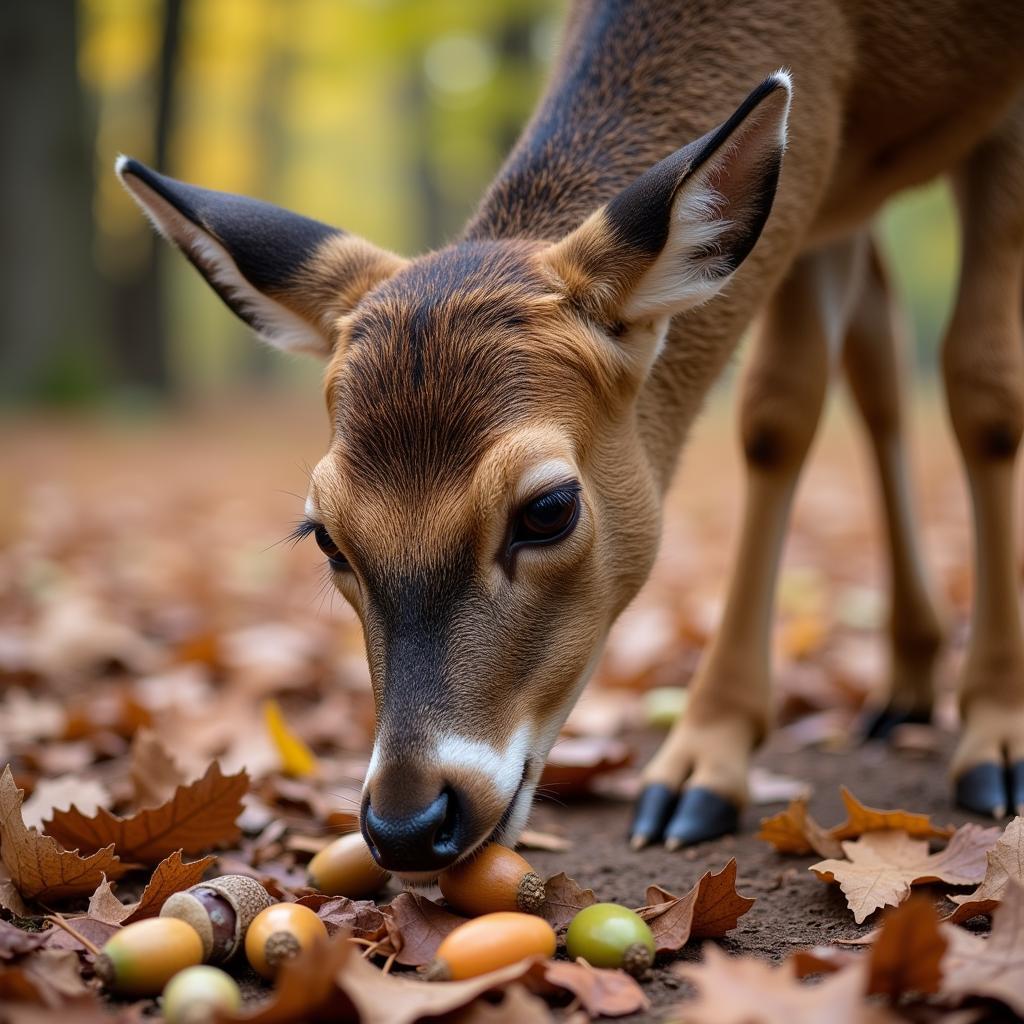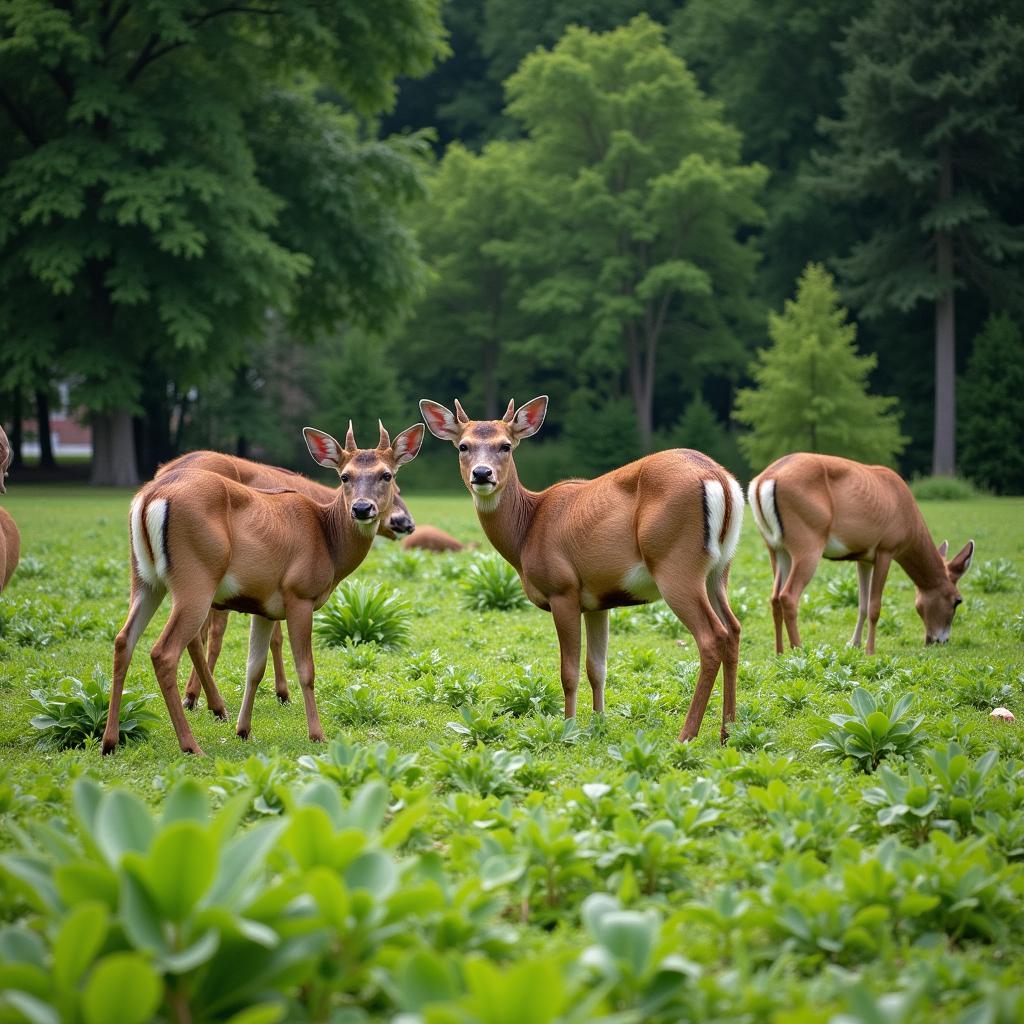Acorns, a readily available and nutritious food source, play a crucial role in the whitetail deer’s diet, especially during fall and winter. Understanding the importance of Acorn Deer Food can help hunters and nature enthusiasts alike appreciate the complex relationship between deer and their environment. Let’s delve into the world of acorns and their significance for deer populations.
Deer rely heavily on high-energy foods like acorns to prepare for the harsh winter months. Acorns are rich in carbohydrates and fats, providing deer with the necessary energy reserves to survive periods of cold temperatures and limited food availability. Having access to a plentiful supply of acorn deer food can significantly impact a deer herd’s health and antler growth. For those interested in attracting deer to their property, understanding the role of acorns is essential. Check out our guide on food plots for turkey for more information on providing supplemental food sources.
The Nutritional Powerhouse: Why Deer Love Acorns
Acorns provide a significant nutritional boost for deer. They are packed with carbohydrates, fats, and essential minerals, making them a valuable food source, particularly during fall and winter. The high fat content in acorns helps deer build up fat reserves, crucial for insulation and energy during cold weather. Additionally, acorns contain minerals like calcium and phosphorus, which are essential for bone growth and overall health.
Whitetail deer have evolved to efficiently digest acorns, despite their tannin content. While tannins can be bitter and inhibit nutrient absorption in some animals, deer have specialized digestive systems that allow them to break down tannins and access the valuable nutrients within acorns.
 Whitetail Deer Eating Acorns in Forest
Whitetail Deer Eating Acorns in Forest
Types of Acorns and Deer Preference
Not all acorns are created equal. Different oak tree species produce acorns with varying levels of tannins and nutritional content. White oak acorns are generally preferred by deer due to their lower tannin levels and sweeter taste compared to red oak acorns, which have higher tannin concentrations. This preference can influence deer movement and foraging patterns, as they will actively seek out areas with abundant white oak trees during the fall. If you’re looking to create a food plot specifically for deer, understanding these preferences can be invaluable. Learn more about creating successful food plots with our article on monster buck food plot seed.
Identifying White Oak and Red Oak Acorns
Differentiating between white and red oak acorns can be helpful for hunters and wildlife enthusiasts. White oak acorns are typically oblong and have a warty cap, while red oak acorns are more rounded with a scaly cap. Observing these subtle differences can provide insights into deer feeding habits and habitat preferences.
 Comparing White Oak and Red Oak Acorns
Comparing White Oak and Red Oak Acorns
Impact of Acorn Crops on Deer Populations
The abundance of acorns in a given year can significantly influence deer populations. A bumper acorn crop can lead to increased fawn survival rates and improved antler growth in bucks. Conversely, a poor acorn crop can result in decreased body condition, reduced reproductive success, and increased vulnerability to disease and predation. Understanding the cyclical nature of acorn production is crucial for managing deer populations and predicting their movement patterns.
“Acorns are a cornerstone of the whitetail deer’s diet,” says Dr. Emily Carter, a wildlife biologist specializing in deer ecology. “The availability of this critical food source directly impacts the health and well-being of deer populations.”
Supplementing Deer Diets: Beyond Acorns
While acorns are a vital food source, providing supplemental food plots can further enhance deer nutrition, especially during times of acorn scarcity. Food plots with a mix of forages like clover, alfalfa, and chicory can provide deer with essential vitamins and minerals, ensuring they maintain optimal health throughout the year. Winter can be particularly challenging for deer, and providing adequate food sources is essential for their survival. Explore our article on deer food plots for winter for more information.
“Strategic food plots can be a valuable tool for supplementing the natural food sources available to deer,” adds Dr. Michael Davis, a wildlife management consultant. “This is especially important in areas where acorn production is inconsistent or during harsh winter conditions.”
 Deer Grazing in Food Plot
Deer Grazing in Food Plot
Conclusion
Acorn deer food is a crucial component of the whitetail deer’s diet, playing a vital role in their survival and overall health. Understanding the importance of acorns, their nutritional value, and the varying preferences of deer for different acorn types can provide valuable insights for hunters, wildlife enthusiasts, and land managers alike. By appreciating the intricate relationship between deer and their environment, we can better manage and conserve these magnificent animals. For those seeking more insights into native food sources, explore our article on kumeyaay food. Optimizing deer habitat and ensuring access to adequate food sources, including acorns and supplemental food plots, is essential for maintaining healthy and thriving deer populations.
FAQ
- What are the primary nutrients found in acorns that benefit deer? (Carbohydrates, fats, and minerals like calcium and phosphorus).
- Why do deer prefer white oak acorns over red oak acorns? (Lower tannin levels and sweeter taste).
- How does acorn availability affect deer populations? (Influences fawn survival, antler growth, and overall herd health).
- What can be done to supplement deer diets when acorns are scarce? (Planting food plots with forages like clover, alfalfa, and chicory).
- How can I identify white oak acorns versus red oak acorns? (White oak acorns are oblong with warty caps; red oak acorns are rounded with scaly caps).
- What is the impact of tannins on deer digestion? (Deer have specialized digestive systems that can break down tannins).
- Why is understanding the role of acorns important for hunters? (Helps predict deer movement and foraging patterns).
Suggest other related articles that are available on the web.
- You may want to learn more about creating the best turkey food plot.
Need help?
Contact us 24/7 for assistance. Phone: 02437655121, Email: minacones@gmail.com. Visit us at 3PGH+8R9, ĐT70A, thôn Trung, Bắc Từ Liêm, Hà Nội, Việt Nam.